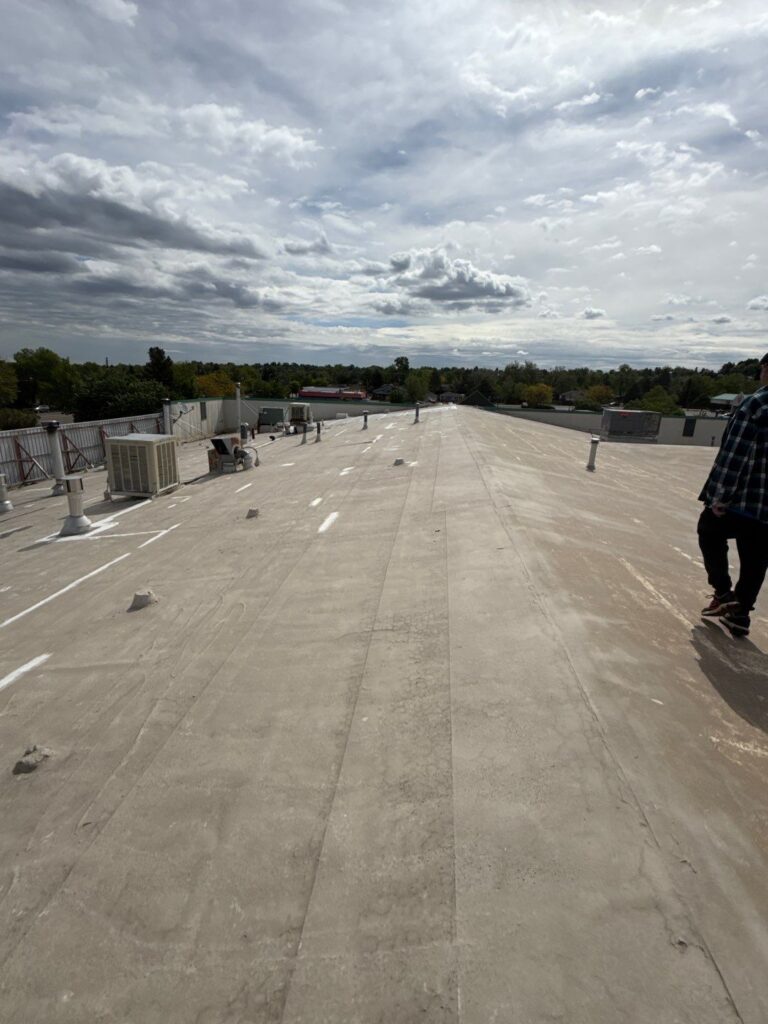
What Is EPDM Roofing?
Ethylene Propylene Diene Monomer, commonly abbreviated as EPDM, is a synthetic rubber membrane specifically engineered for roofing applications. This resilient material is predominantly used on commercial buildings featuring flat or low-slope designs. Its composition—flexible, weather-resistant, and cost-efficient—makes it a top contender for long-term performance in demanding environments.
EPDM membranes are usually black but can also be manufactured in white or light grey for energy efficiency purposes. Available in large rolls, they are installed in seamless sheets to minimize leak points. Whether ballasted, mechanically attached, or fully adhered, EPDM systems are crafted to endure UV exposure, temperature shifts, and moisture infiltration.
Why EPDM Roofing Is Ideal for Flat and Low-Slope Structures
Unlike steep-slope roofing systems that rely on gravity to channel water, flat and low-slope roofs require materials that offer complete water resistance. EPDM roofing answers this need with a monolithic membrane that prevents water intrusion. In climates like Denver’s, where weather conditions can be unpredictable and harsh, such a solution becomes indispensable for commercial structures.
Building codes typically prohibit the use of shingles on roofs with a slope less than 2:12. For these configurations, EPDM and similar membranes provide both compliance and functionality. EPDM’s elasticity also accommodates building movement and structural expansion without compromising the integrity of the roof.
Advantages of Choosing EPDM Roofing
1. Long-Term Reliability
We implement EPDM systems for clients seeking proven longevity. When properly installed and maintained, EPDM membranes can deliver over three decades of service life. They resist cracking, warping, and degradation from prolonged UV and ozone exposure. This durability reduces the frequency of costly repairs and replacement projects.
2. Streamlined Installation Process
EPDM roofing is favored in part due to its installation efficiency. Instead of laying down individual components like shingles or tiles, we apply wide rolls of EPDM directly to the roofing surface. This allows us to complete projects faster and reduces labor costs for the property owner.
3. Superior Weather Performance
We trust EPDM membranes to hold up against wind-driven rain, hail, ice, and snow. Their flexible nature allows the system to expand and contract with temperature changes, which is essential for buildings located in Denver’s four-season climate.
4. Minimal Maintenance Requirements
Once installed, EPDM roofs demand minimal upkeep. Regular inspections and debris removal typically suffice. Seam reinforcements and minor repairs, when necessary, can be conducted easily without dismantling the entire roof system.
Considerations Before Choosing EPDM
1. Surface Water Management
Even though EPDM is waterproof, improper roof drainage can lead to water ponding—an issue that undermines the effectiveness of any flat roof system. We recommend integrating proper slope adjustments and internal drainage systems to mitigate this risk.
2. Energy Efficiency Factors
Traditional EPDM membranes are black and may absorb heat during the summer months. For clients concerned with energy usage, we suggest considering white EPDM or applying reflective coatings that deflect sunlight and reduce interior cooling loads.
3. Aesthetic Limitations
For some property owners, EPDM may not offer the desired aesthetic appeal. The visual design is functional but not decorative. If curb appeal is a priority, we may guide clients toward other flat-roof systems that balance aesthetics with performance.
Comparing EPDM to Other Flat Roofing Options
While EPDM has a strong track record, it’s essential to compare it against other modern roofing solutions:
- TPO (Thermoplastic Polyolefin) is highly reflective and offers strong energy efficiency benefits but hasn’t yet matched EPDM’s decades of proven durability.
- PVC (Polyvinyl Chloride) provides excellent chemical resistance and weldable seams but comes with a higher price tag and increased installation complexity.
- Silicone Roof Coatings offer extreme weather resistance and longevity but are more suitable as a restoration product rather than a primary roofing membrane.
We help clients make informed decisions by evaluating their specific structural requirements, budget constraints, and energy goals.
Maintenance Tips for EPDM Roof Owners
Proper upkeep ensures the long life and functionality of an EPDM roof. Here’s how we maintain optimal performance over time:
- Inspect biannually and after severe storms for signs of punctures, seam separation, or membrane shrinkage.
- Remove debris that can clog drains or damage the surface.
- Ensure proper drainage by clearing scuppers, downspouts, and internal drains.
- Recoat reflective layers every few years if a white or light-colored system is installed.
We also recommend a professional inspection once a year to preemptively address minor issues before they escalate.
Ideal Applications for EPDM Roofing
EPDM is a smart choice for:
- Office complexes
- Distribution centers
- Medical facilities
- Retail buildings
- Educational institutions
In regions like Denver, Colorado, where temperature shifts, hailstorms, and high UV exposure are regular occurrences, EPDM provides a stable, protective barrier. For commercial clients seeking value-driven performance, EPDM offers an exceptional return on investment.
Conclusion
EPDM roofing systems combine resilience, affordability, and low maintenance to create a roofing solution built for longevity and reliability. Their adaptability to flat and low-slope structures, especially in challenging climates like Denver, makes them a trusted option for commercial facilities.
If you’re seeking a dependable installation of EPDM or other commercial roofing systems, Tried and True Roofing, a reputable roofing company in Denver, Colorado, offers professional service rooted in quality and experience.

